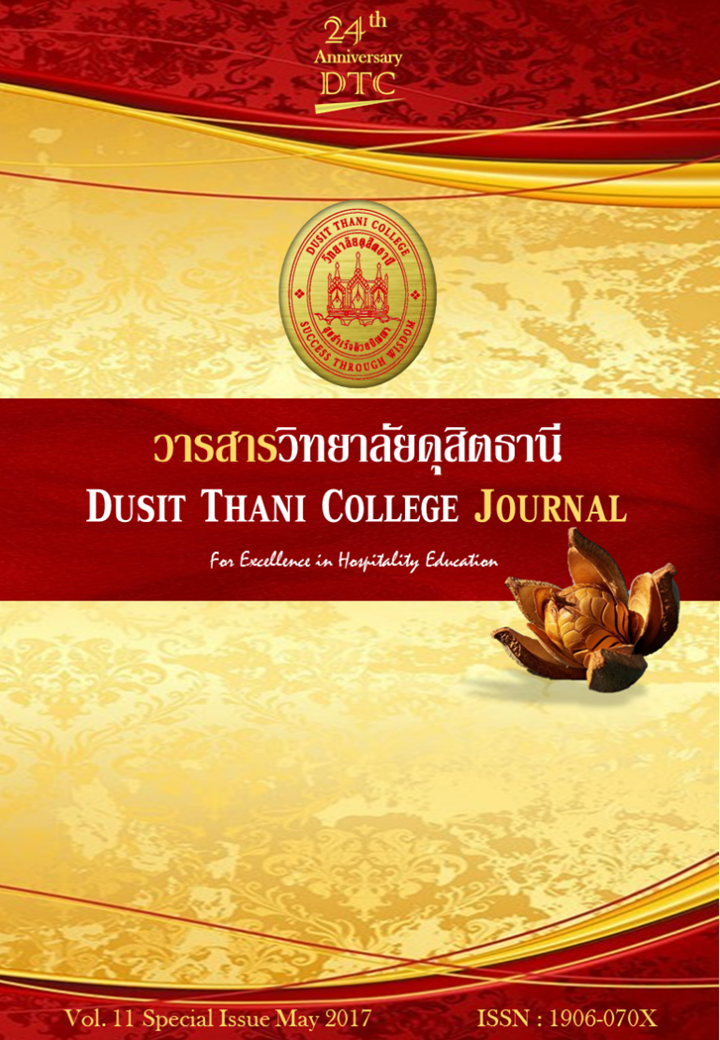Customer Satisfaction and Relationship Marketing in Hotel Business
Main Article Content
Abstract
This article intends to present Relationship marketing emphasizes the importance of creating and maintaining customer relations, supplier or service provider and other business-related organizations in order to attract new customers and retain exist customers. Marketing relationship Yield can be increased with a better understanding of the customer. Especially in the hotel business, the Organization must recognize the importance of creating a sustainable and long-term relationships with customers by understanding their satisfaction with the services provided will make the organization and the employee realizes the value of creating and maintaining the satisfaction of individuals associated with the service, both as a service provider and customer, which is a key role in the service process. When a customer has good feelings and moments in the service that meets the expectations or requirements, and then will bring competitive advantages. The quality of service that will keep most satisfied customers depend on physical evidences such as location, personality, skills, equipment, etc.
Article Details
Article Screening Policy
- All research and academic articles to be published must be considered and screened by three peer reviews in the relevant field / article.
- All articles, texts, illustrations and tables published in the journal are the personal opinions of the authors. Editors don't always have to agree. And no responsibility whatsoever is the sole responsibility of the author.
- The articles to be published must never be published. Where did you first publish? And not in the consideration of other journals If the audit found that there has been a duplicate publication It is the sole responsibility of the author.
- Any article that the reader sees as being plagiarized or impersonated without reference. Or mislead the work of the author Please let the journal editor know it will be your greatest blessing.
References
8(4),1-15.
Battor, M., &Battor, M. (2010). ”The impact of customer relationship management capability on innovation and performance advantages: Testing a mediated model.”Journal of Marketing Management,26(9-10),842-857.
Berry, L. (2000). Growing Interest, Emerging Perspectives. In Sheth, J., Parvatiyar, A. Handbook of Relationship Marketing. California: Sage Publications: 149-170.
Buttle, F. B. (1996). Relationship marketing theory and practice.Paul Chapman, LondonCambridge, MA :Marketing Science Institute.
Campón-Cerro, A. (2010). “Hernández-Mogollón, J. &Alves, H. Marketing Relacional e Turismo: A fidelização de Clientes no Turismo Rural, Proposta de um Modelopara o seuEstudo”. RevistaTurismo&Desenvolvimento, 1(13/14), 231-241.
Chang, H.H. (2007). “Critical factors and benefits in the implementation of customer relationship management”.Total Quality Management & Business Excellence,18(5), 483-508.
Dachakupt, J. (1997). Psychology of Tourism Industry Administration.Bangkok :Chulalongkorn
University Press.
Egan J. (2001). Relationship Marketing.Prentice Hall.
Grönroos, C. (200). Service Management and Marketing: A Customer Relationship Management Approach, Wiley & Sons, Inc., New York, NY.
Kanagal N. (2000). “Role of Relationship Marketing in Competitive Marketing Strategy”. Journal of Management and Marketing Research.
Kasim and Minai. (2009). “Linking CRM strategy, customer performance measures and performance in the hotel industry”. International Journal of Economics and Management,3(2),297-316.
Kotler, P. and Keller,K.L. (2006). Marketing Management. (12th ed.). Upper Saddle River, New Jersey: Pearson Prentice Hall.
Kotler P., Bowen J. and Makens J. (2013). Marketing for Hospitality and Tourism. (6thed.). Prentice Hall, New Jersey.
Möller, K. &Halinen, A. (2000). “Relationship Marketing Theory: Its Roots andDirection”. Journal of Marketing Management.16 (1-3), 29–54.
MukcharoenphonB.(2012). Satisfaction of Customer in Bangkok toward TRUE CRM.Master of Business Administration, Gradute School, Bangkok University.
SukhothaiThammathirat Open University. (1996). Service Psychology.(3rded.,) Nonthaburi :Homeeconomics.SukhothaiThammathirat Open University.
Suksumlid J. (2007). Relationship between customer relationship management, Customer Satisfaction and Customer Loyalty to Mobile Network Company.Master of Business Administrative, Marketing, Graduate School, Sriprathum University.
Palmatier, R.W., Dant, R.P., Grewal, D. & Evans, K.R. (2005). “FactorsInfluencing the Effectiveness of Relationship Marketing: A Meta-Analysis. Journal of Marketing”.70 (4), 136–153.
Payne, A.F.T. and Frow, P., (2006). A strategic framework for customer relationship management.Journal of Marketing, Volume 69 (4).
Peltier, JW., Pointer, L., and Schibrowsky, JA. (2006). “Internal Marketing and the Antecedents of Nurse Satisfaction and Loyalty”.Health Marketing Quarterly, 23(4), 75-108.
Proctor, T.(2000). Strategic Marketing: An Introduction.London: Routledge.
Ratnasingam, P. and Phan, DD. (2003). “Trading Partner Trust in B2B E-Commerce: A Case Study”. Information Systems Management, 20(3), 39-50.
Ronald E. Goldsmith and Rodoula H. Tsiotsou. (2012). Strategic Marketing in Tourism Services.Emerald Group Publishing Limited. Bingley, United Kingdom.
Sinsungsud W. and Sinsungsud W. (2006). How to create customer satisfaction.Bangkok:
Saijai Press.


